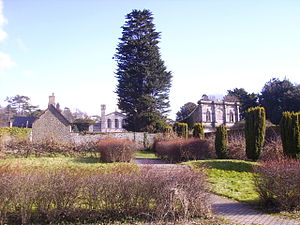- Margam Country Park
-
Margam County Park
View from the Orangery GardensType Country Park Location Margam, Neath Port Talbot, Wales Coordinates 51°33′46″N 3°43′32″W / 51.56278°N 3.72556°WCoordinates: 51°33′46″N 3°43′32″W / 51.56278°N 3.72556°W Created 1977 Operated by Neath Port Talbot County Borough Council Status Open all year Website Official website Margam Country Park is a country park estate in Britain, of around 850 acres (3.4 km²). It is situated in Margam, about 2 miles (3 km) from Port Talbot in south Wales it was once owned by the Mansel Talbot family and is now owned and administered by the local council, Neath Port Talbot County Borough Council. Situated within the park are three notable buildings: Margam Abbey, a Cistercians monastery; Margam Castle, a neo-Gothic country house that was once the seat of the Mansel Talbot family; and the 18th-century Orangery.
Contents
County Park
Margam Park owes its location and beginnings to the monastery, which was acquired by Sir Rice Mansel in 1540 after the Dissolution of the Monasteries in 1537. A Tudor mansion was later built on the site of the former monastic ranges by Sir Rice Mansel as a county residence. In 1661, the first mention of a garden are referenced, including walled areas and by 1727 the estate's gardener drew up a catalogue of the plants at the gardens. 1793 saw the completion of the Orangery and by the late 18th century the gardens are fenced off from the park to keep out the deer, and a main gate is erected. An 1814 estate map shows that a working park had been realised, with a 'Great', 'Little' and 'Upper' Parks, and by 1830 the construction of a new manor house, to become Margam Castle, had begun. Before the end of the decade, plans show the inclusion of several new buildings and features, including the Temple of the Four Seasons, the stone facade and the gardener's cottage.
The Margam Estate was acquired by Glamorgan County Council in July 1973, and the next year, after a Local Government re-organisation, the Park fell under the ownership of West Glamorgan County Council. The park was officially opened to the public in 1977.
The estate is noted for its peacock population. Also on the estate are deer, which have existed on the site since at least Norman times. The majority are fallow deer (numbering around 230); red deer (about 60) and the non-native Père David's Deer (about 30) were introduced in the 1990s, the latter as part of a breeding programme. Venison from the management of the deer herd is sold to the public. Aviaries on the estate house a number of rescued birds of prey. The rare breed Glamorgan cattle are raised on the estate.
The Coed Morgannwg Way and the Ogwr Ridgeway Walk long-distance paths go through Margam Country Park, and there are a number of shorter (less than three miles (5 km)) walks waymarked in the park. There are no major rivers in the park, but there are lakes and ponds, and it is possible to fish some of the ponds.
A narrow gauge railway conducts visitors around the grounds in the summer. The Orangery has a licence for civil marriages. Events on the estate are held through the summer: anything from fairs selling particular goods to car rallies. The Margam Country Show is held in August. In 2003, the park was host to the Urdd Eisteddfod.
Access is free but there is a charge for car parking and for some events.
Margam Abbey
Main article: Margam AbbeyIn 1147, Margam Abbey was built. Its remains stand in the park today.
Margam Castle
Main article: Margam CastleTh Park also houses Margam Castle, a Tudor Gothic mansion house built by Christopher Rice Mansel Talbot in the early nineteenth century, and an Iron Age hillfort. Sculptures and artwork are placed at different places along the paths which connect the house with the Orangery.
See also
- List of gardens in Wales
External links
- Margam Country Park Official site
- Margam Country Park Site from South West Wales Tourist Board
- Margam Park Field Centre
- Photos of Margam Country Park and surrounding area on geograph
Categories:- Gardens in Wales
- Geography of Neath Port Talbot
- Country parks in Wales
- 2ft gauge railways
- Visitor attractions in Neath Port Talbot
Wikimedia Foundation. 2010.

